Atomic Layer-Deposited Al-Doped ZnO Thin Films for Display Applications
Abstract
:1. Introduction
2. Materials and Methods
3. Results and Discussion
3.1. AZO Layers Characterisations
3.1.1. Structural Analysis
3.1.2. Optical Properties
3.1.3. Electrical Properties
3.1.4. Bending Ability Test of AZO/PET Flexible Substrates
3.2. Applications of AZO Transparent Conductive Layer for Display Applications
3.2.1. AZO as Transparent Conductive Layer in Rigid LC Display
3.2.2. AZO as Transparent Conductive Layer in Flexible Display (Smart Structures)
3.2.3. Electro-Optical Characteristics and Bending Test Ability
4. Conclusions
Author Contributions
Funding
Acknowledgments
Conflicts of Interest
References
- Ellmer, K. Past achievements and future challenges in the development of optically transparent electrodes. Nat. Photonics 2012, 6, 809–817. [Google Scholar] [CrossRef]
- Gordon, R.G. Criteria for choosing transparent conductors. MRS Bull. 2000, 25, 52–57. [Google Scholar] [CrossRef] [Green Version]
- Morales-Masis, M.; De Wolf, S.; Woods-Robinson, R.; Ager, J.W.; Ballif, C. Transparent electrodes for efficient optoelectronics. Adv. Electron. Mater. 2016, 3, 1600529. [Google Scholar] [CrossRef] [Green Version]
- Levy, D.; Castellon, E. Transparent Conductive Materials: Materials, Synthesis, Characterization, Applications, 1st ed.; Wiley-VCH Verlag Gmbh &Co, KGaA: Weinheim, Germany, 2018. [Google Scholar]
- Transparent Conductive Films Market by Application (Smartphones, Tablets, Notebooks, LCDs, Wearable Devices), Material (ITO on Glass, ITO on PET, Metal Mesh, Silver Nanowires, Carbon Nanotubes), and Region-Global Forecast to 2026. Available online: https://www.marketsandmarkets.com/Market-Reports/transparent-conductive-film-market-59909084.html (accessed on 30 April 2020).
- Suzuki, A.; Matsushita, T.; Wada, N.; Sakamoto, Y.; Okuda, M. Transparent conducting Al-doped ZnO thin films prepared by pulsed laser deposition. Jpn. J. Appl. Phys. 1996, 35, L56–L59. [Google Scholar] [CrossRef]
- Berginski, M.; Hupkes, J.; Schulte, M.; Schope, G.; Stiebig, H.; Rech, B.; Wuttig, M. The effect of front ZnO:Al surface texture and optical transparency on efficient light trapping in silicon thin-film solar cells. J. Appl. Phys. 2007, 101, 074903. [Google Scholar] [CrossRef]
- Minami, T.; Sato, H.; Nanto, H.; Takata, S. Heat treatment in hydrogen gas and plasma for transparent conducting oxide films such as ZnO, SnO2 and indium tin oxide. Thin Solid Films 1989, 176, 277–282. [Google Scholar] [CrossRef]
- Dhere, R.G.; Bonnet-Eymard, M.; Charlet, E.; Peter, E.; Duenow, J.N.; Li, J.V.; Kuciauskas, D.; Gessert, T.A. CdTe solar cell with industrial Al:ZnO on soda-lime glass. Thin Solid Films 2011, 519, 7142–7145. [Google Scholar] [CrossRef]
- Vasekar, P.S.; Dhere, N.G.; Moutinho, H. Development of CIGS2 solar cells with lower absorber thickness. Sol. Energy 2009, 83, 1566–1570. [Google Scholar] [CrossRef]
- Park, S.; Ikegami, T.; Ebihara, K. Growth of transparent conductive Al-doped ZnO thin films and device applications. Jpn. J. Appl. Phys. 2006, 45, 8453–8456. [Google Scholar] [CrossRef]
- Verma, A.; Khan, F.; Kumar, D.; Kar, M.; Chakravarty, B.C.; Singh, S.N.; Husain, M. Sol–gel derived aluminum doped zinc oxide for application as anti-reflection coating in terrestrial silicon solar cells. Thin Solid Films 2010, 518, 2649–2653. [Google Scholar] [CrossRef]
- Mondragon-Suarez, H.; Maldonado, A.; de la L Olvera, M.; Reyes, A.; Castanedo-Perez, R.; Torres-Delgado, G.; Asomoza, R. ZnO:Al thin films obtained by chemical spray: Effect of the Al concentration. Appl. Surf. Sci. 2002, 193, 52–59. [Google Scholar] [CrossRef]
- Ma, J.; Ji, F.; Ma, H.; Li, S. Preparation and properties of transparent conducting zinc oxide and aluminium-doped zinc oxide films prepared by evaporating method. Sol. Energy Mater. Sol. Cells 2000, 60, 341–348. [Google Scholar] [CrossRef]
- Liu, Y.; Lian, J. Optical and electrical properties of aluminum doped ZnO thin films grown by pulsed laser deposition. Appl. Surf. Sci. 2007, 253, 3727–3730. [Google Scholar] [CrossRef]
- Yang, W.; Wu, Z.; Liu, Z.; Pang, A.; Tu, Y.; Feng, Z.C. Room temperature deposition of Al-doped ZnO films on quartz substrates by radio-frequency magnetron sputtering and effects of thermal annealing. Thin Solid Films 2010, 519, 31–36. [Google Scholar] [CrossRef]
- Kon, M.; Song, P.K.; Shigesato, Y.; Frach, P.; Mizukami, A.; Suzuki, K. Al-doped ZnO films deposited by reactive magnetron sputtering in mid-frequency mode with dual cathodes. Jpn. J. Appl. Phys. 2002, 41, 814–819. [Google Scholar] [CrossRef]
- Tynell, T.; Yamauchi, H.; Karppinen, M.; Okazaki, R.; Terasaki, I. Atomic layer deposition of Al-doped ZnO thin films. J. Vac. Sci. Technol. A 2013, 31, 01A109. [Google Scholar] [CrossRef] [Green Version]
- Johnson, R.W.; Hultqvist, A.; Bent, S.F. A brief review of atomic layer deposition: From fundamentals to applications. Mater. Today 2014, 17, 236–246. [Google Scholar] [CrossRef]
- Dhakal, T.; Nandur, A.S.; Christian, R.; Vasekar, P.; Desu, S.; Westgate, C.; Koukis, D.I.; Arenas, D.J.; Tanner, D.B. Transmittance from visible to mid infra-red in AZO films grown by atomic layer deposition system. Sol. Energy 2012, 86, 1306–1312. [Google Scholar] [CrossRef]
- Tulzo, H.L.; Schneider, N.; Lincot, D.; Patriarche, G.; Donsanti, F. Impact of the sequence of precursor introduction on the growth and properties of atomic layer deposited Al-doped ZnO films. J. Vac. Sci. Technol. A 2018, 36, 041502. [Google Scholar] [CrossRef] [Green Version]
- Blagoev, B.S.; Dimitrov, D.Z.; Mehandzhiev, V.B.; Kovacheva, D.; Terziyska, P.; Pavlic, J.; Lovchinov, K.; Mateev, E.; Leclercq, J.; Sveshtarov, P. Electron transport in Al-doped ZnO nanolayers obtained by atomic layer deposition. J. Phys. Conf. Ser. 2016, 700, 012040. [Google Scholar] [CrossRef]
- Sweet, W.J., III; Jur, J.S.; Parsons, G.N. Bi-layer Al2O3/ZnO atomic layer deposition for controllable conductive coatings on polypropylene nonwoven fiber mats. J. Appl. Phys. 2013, 113, 194303. [Google Scholar] [CrossRef]
- Yeh, P.; Gu, C. Optics of Liquid Crystal Display; Wiley Interscience: New York, NY, USA, 2010. [Google Scholar]
- Khoo, I.C. Liquid Crystals Physical Properties and Nonlinear Optical Phenomena; Wiley: Hoboken, NJ, USA, 1995. [Google Scholar]
- Haacke, G. New figure of merit for transparent conductors. J. Appl. Phys. 1976, 47, 4086–4089. [Google Scholar] [CrossRef]
- Oh, B.-Y.; Jeong, M.-C.; Moon, T.-H.; Lee, W.; Myoung, J.-M.; Hwang, J.-Y.; Seo, D.-S. Transparent conductive Al-doped ZnO films for liquid crystal displays. J. Appl. Phys. 2006, 99, 124505. [Google Scholar] [CrossRef]
- Su, Y.C.; Chiou, C.C.; Marinova, V.; Lin, S.H.; Bozhinov, N.; Blagoev, B.; Babeva, T.; Hsu, K.Y.; Dimitrov, D.Z. Atomic layer deposition prepared Al-doped ZnO for liquid crystal displays applications. Opt. Quantum Electron. 2018, 50, 205. [Google Scholar] [CrossRef]
- Baetens, R.; Jelle, B.P.; Gustavsen, A. Properties, requirements and possibilities of smart windows for dynamic daylight and solar energy control in buildings: State-of-the-art. Sol. Energy Mater. Sol. Cells 2010, 94, 8–105. [Google Scholar] [CrossRef] [Green Version]
- Chung, S.H.; Noh, H.Y. Polymer-dispersed liquid crystal devices with graphene electrodes. Opt. Express 2015, 23, 32149. [Google Scholar] [CrossRef]
- Sannicolo, T.; Lagrange, M.; Cabos, A.; Celle, C.; Simonato, J.P.; Bellet, D. Metallic Nanowire-based transparent electrodes for next generation flexible devices: A review. Small 2016, 12, 6052–6075. [Google Scholar] [CrossRef]
- Huang, Q.; Shen, W.; Fang, X.Z.; Chen, G.; Yang, Y.; Huang, J.; Tan, R.; Song, W. Highly thermostable, flexible, transparent, and conductive films on polyimide substrate with an AZO/AgNW/AZO structure. ACS Appl. Mater. Interfaces 2015, 7, 4299–4305. [Google Scholar] [CrossRef]
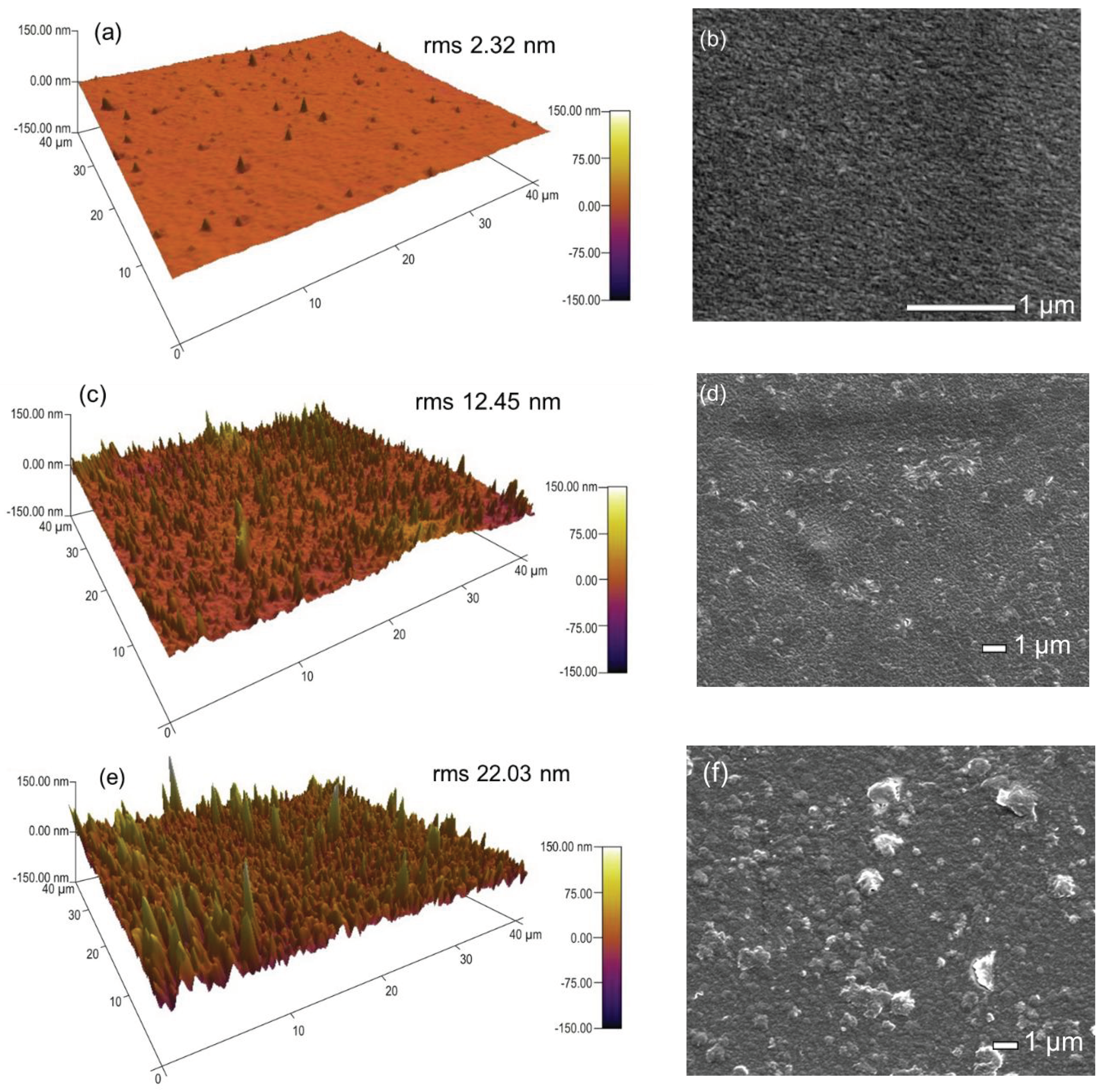
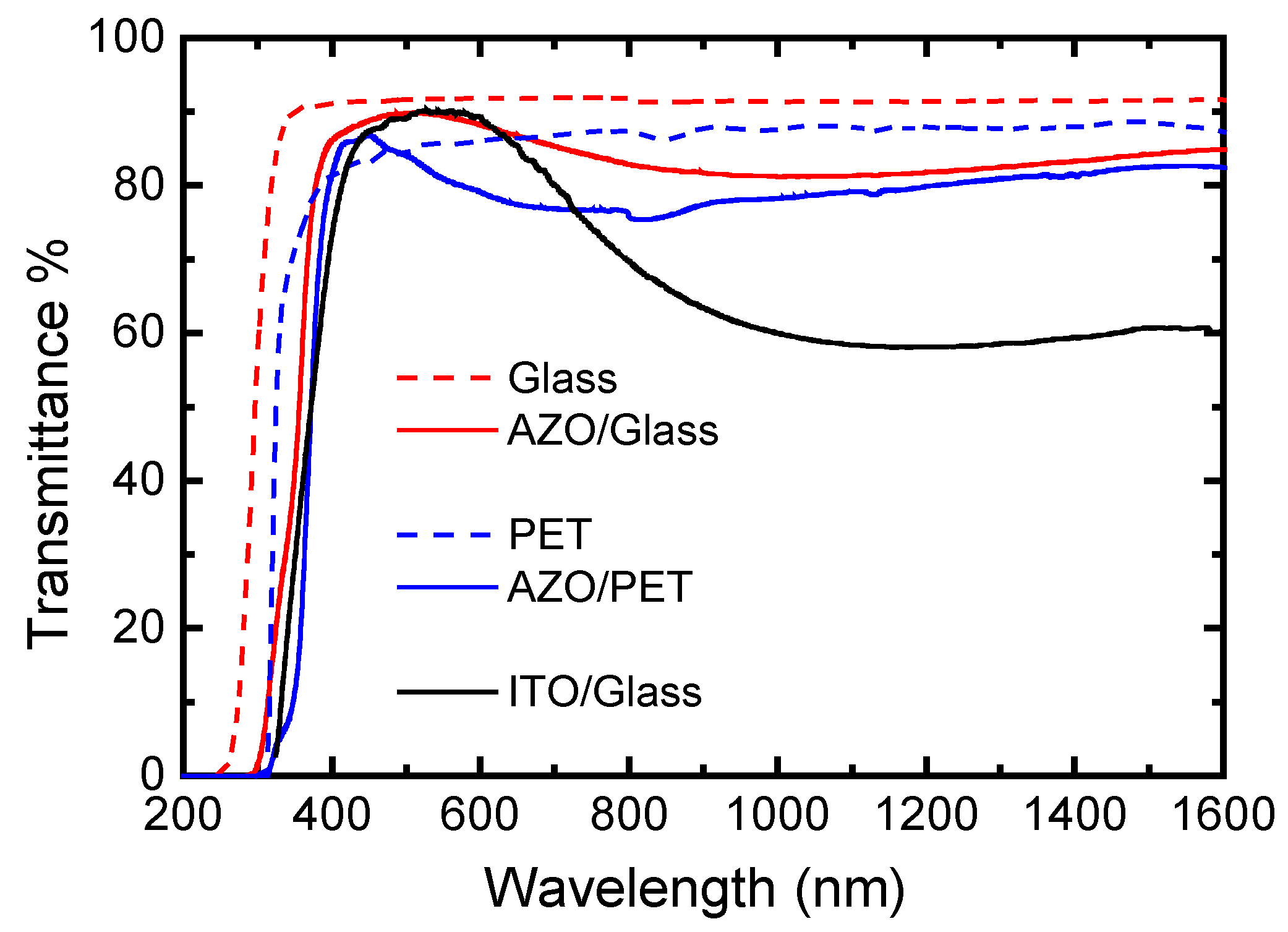
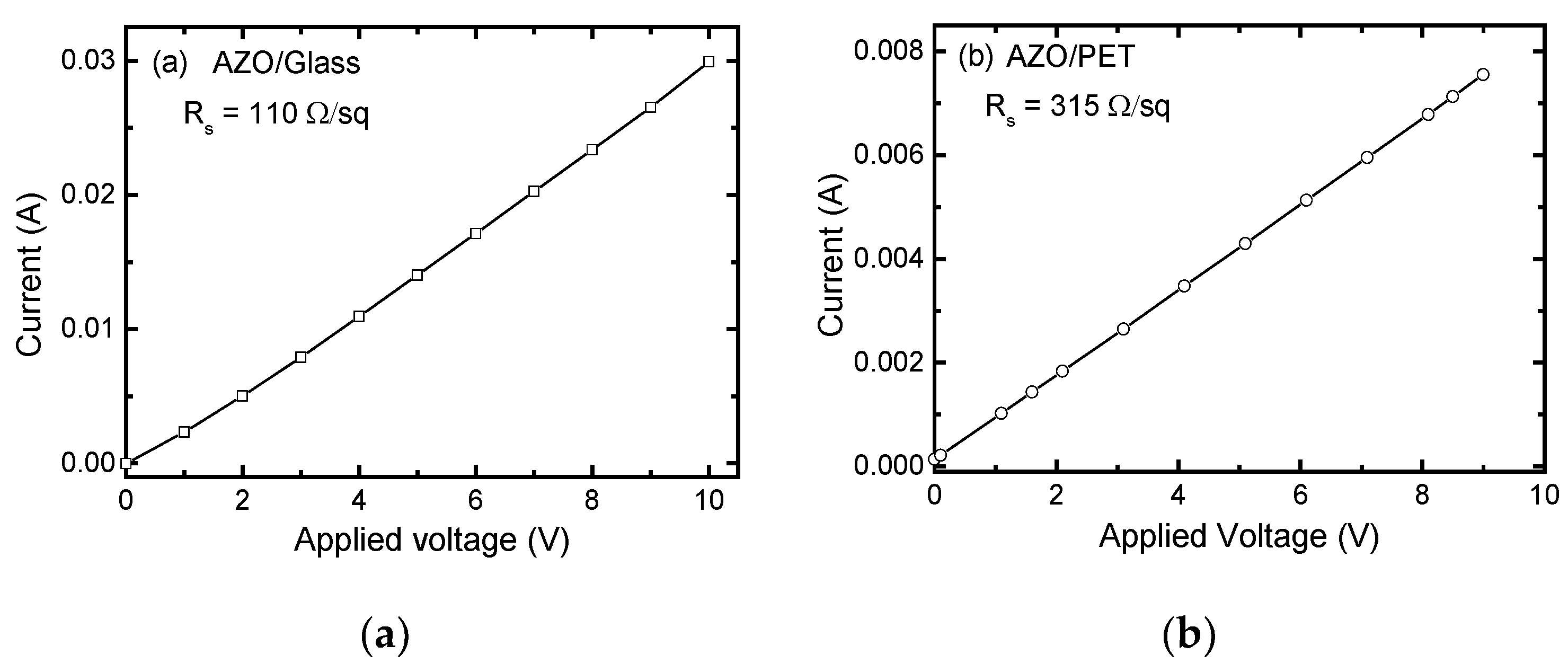
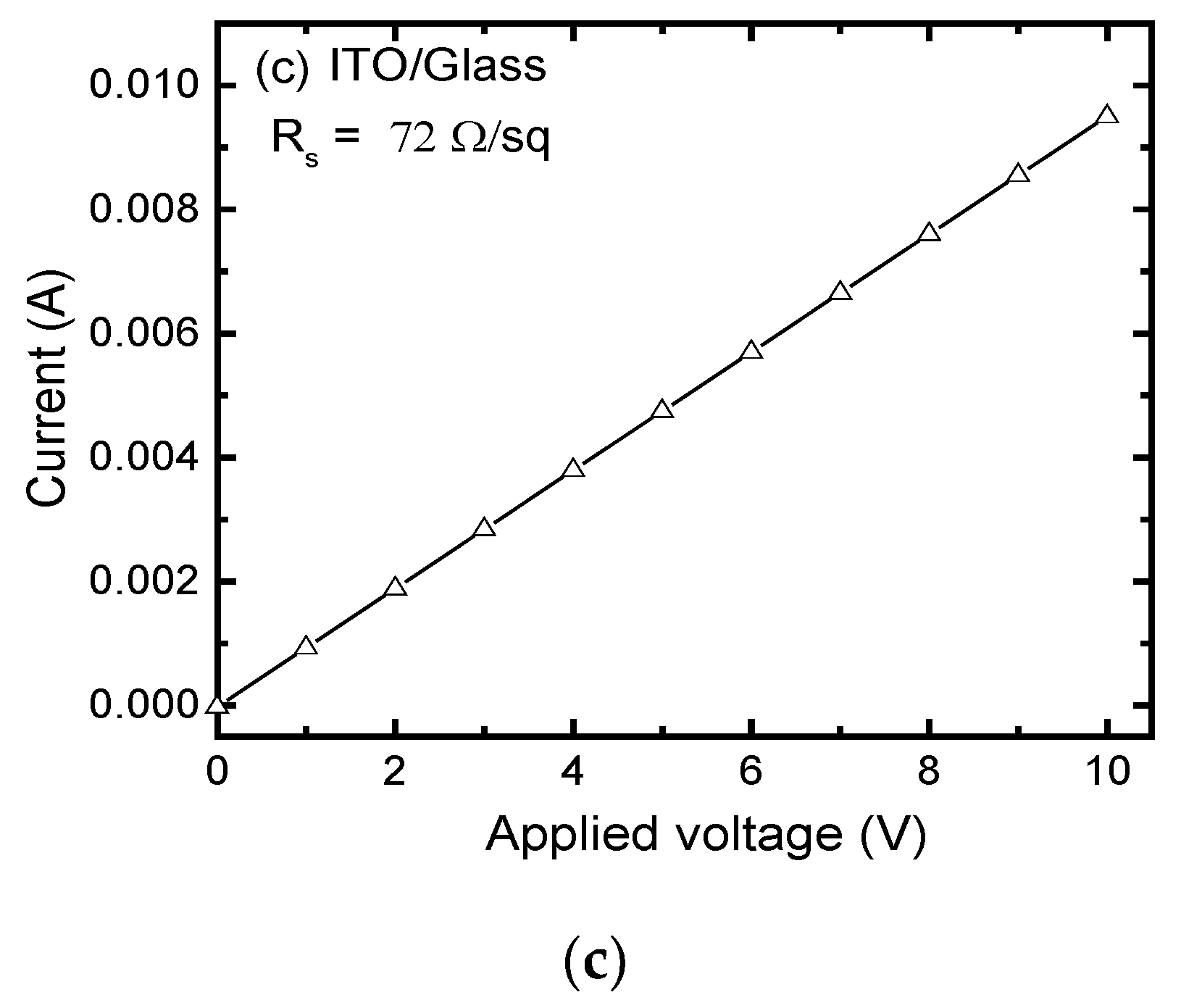
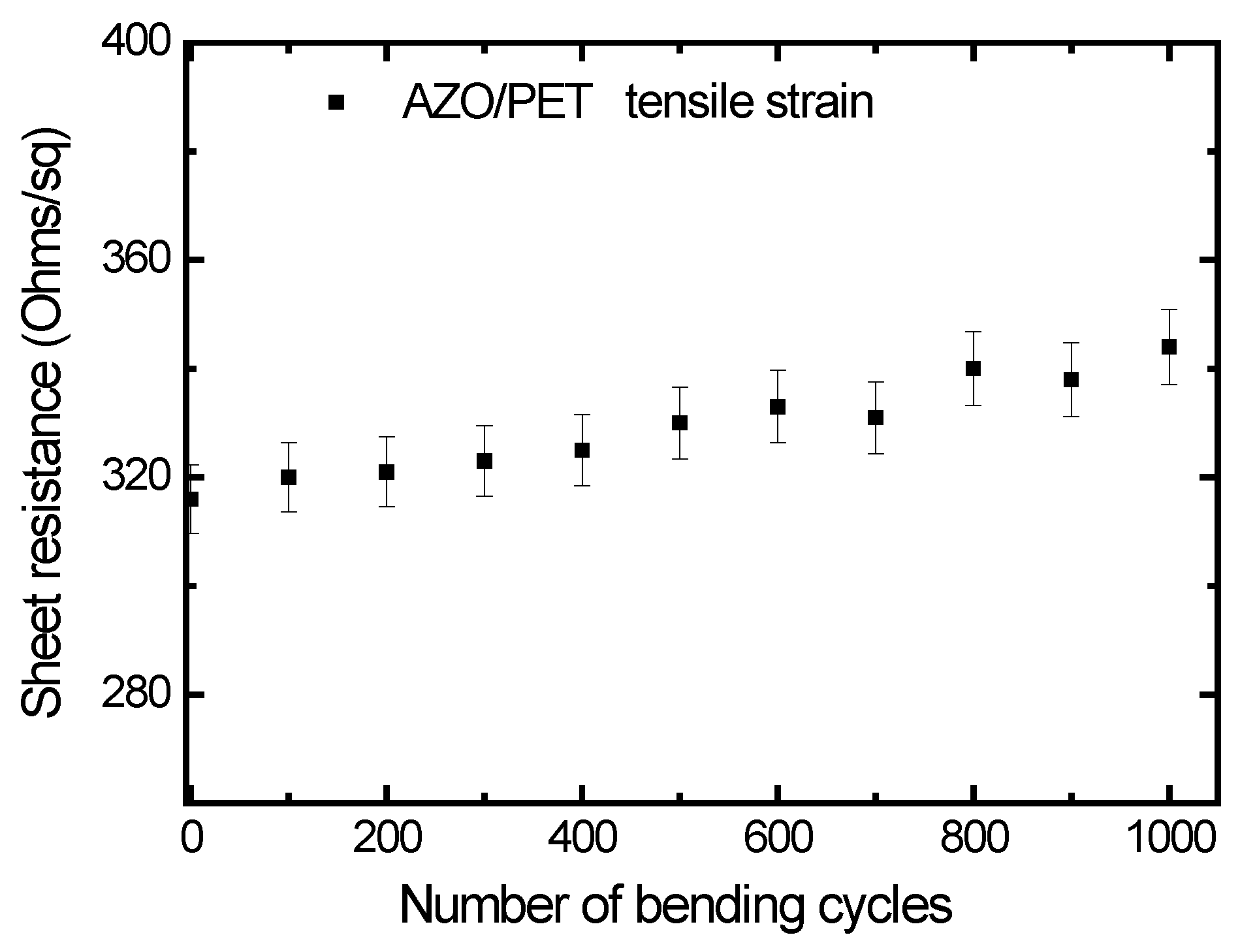
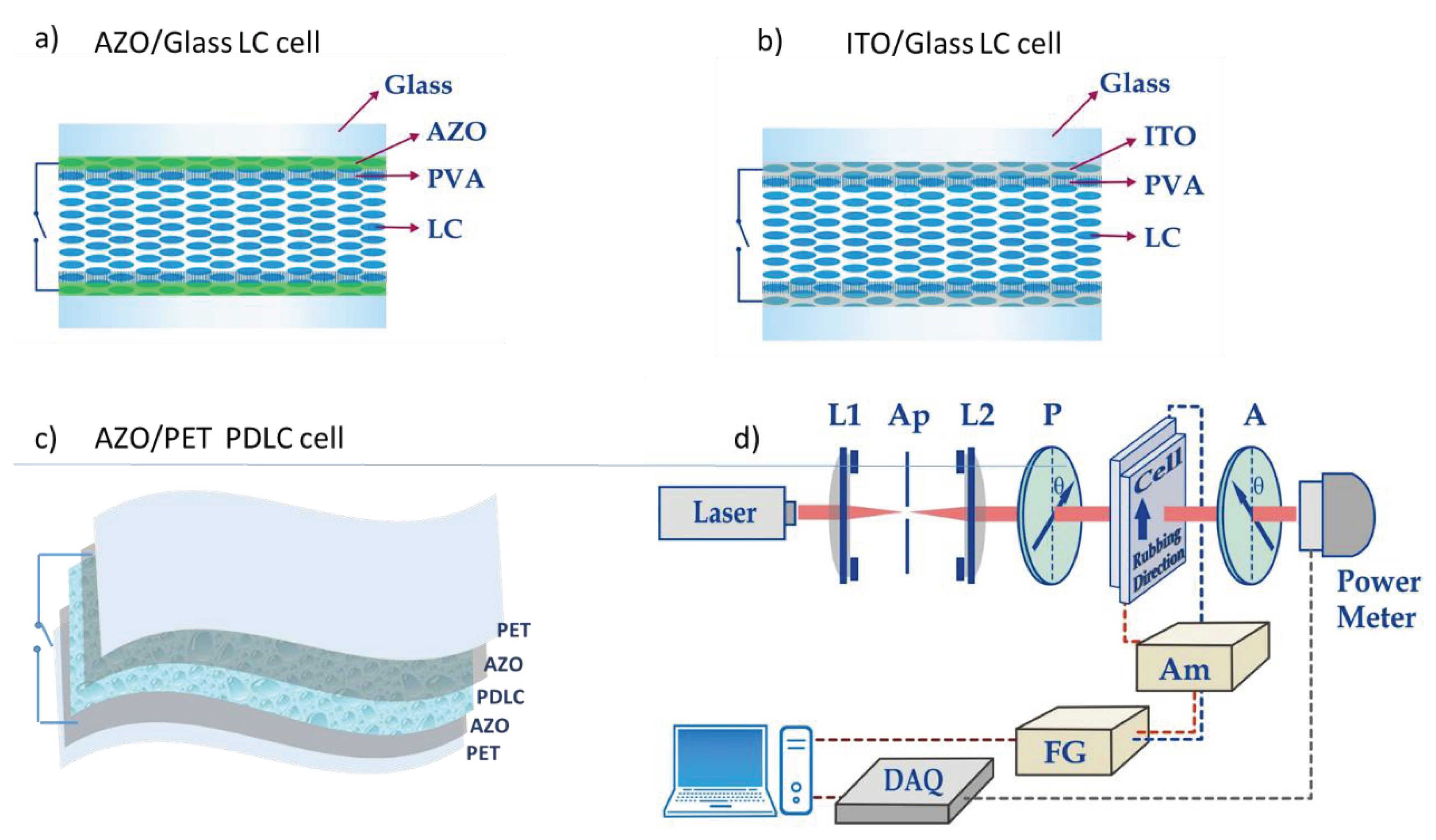
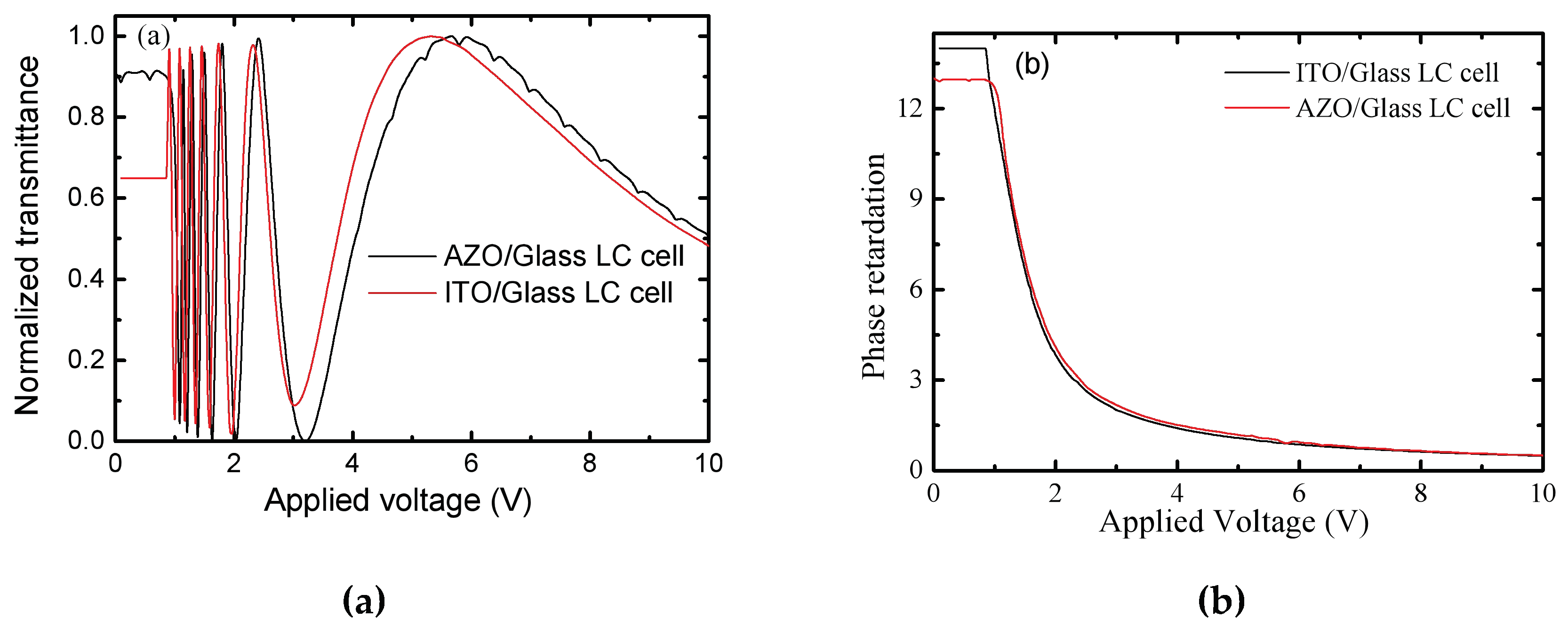
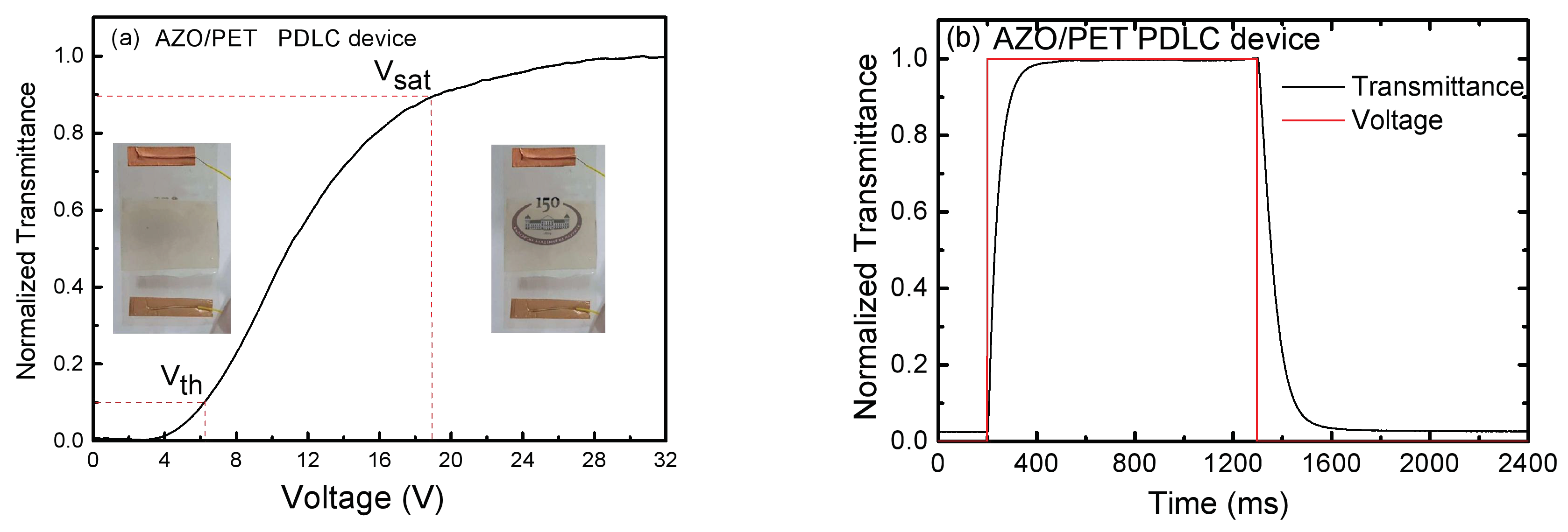
| LC Cell Type | Tav (%) | Rs (Ω/sq) | FOM (Ω−1) |
|---|---|---|---|
| AZO/Glass | 80.6 | 110 | 1.05 × 10−3 |
| ITO/Glass | 84.3 | 72 | 2.52 × 10−3 |
© 2020 by the authors. Licensee MDPI, Basel, Switzerland. This article is an open access article distributed under the terms and conditions of the Creative Commons Attribution (CC BY) license (http://creativecommons.org/licenses/by/4.0/).
Share and Cite
Dimitrov, D.; Tsai, C.-L.; Petrov, S.; Marinova, V.; Petrova, D.; Napoleonov, B.; Blagoev, B.; Strijkova, V.; Hsu, K.Y.; Lin, S.H. Atomic Layer-Deposited Al-Doped ZnO Thin Films for Display Applications. Coatings 2020, 10, 539. https://doi.org/10.3390/coatings10060539
Dimitrov D, Tsai C-L, Petrov S, Marinova V, Petrova D, Napoleonov B, Blagoev B, Strijkova V, Hsu KY, Lin SH. Atomic Layer-Deposited Al-Doped ZnO Thin Films for Display Applications. Coatings. 2020; 10(6):539. https://doi.org/10.3390/coatings10060539
Chicago/Turabian StyleDimitrov, Dimitre, Che-Liang Tsai, Stefan Petrov, Vera Marinova, Dimitrina Petrova, Blagovest Napoleonov, Blagoy Blagoev, Velichka Strijkova, Ken Yuh Hsu, and Shiuan Huei Lin. 2020. "Atomic Layer-Deposited Al-Doped ZnO Thin Films for Display Applications" Coatings 10, no. 6: 539. https://doi.org/10.3390/coatings10060539
APA StyleDimitrov, D., Tsai, C.-L., Petrov, S., Marinova, V., Petrova, D., Napoleonov, B., Blagoev, B., Strijkova, V., Hsu, K. Y., & Lin, S. H. (2020). Atomic Layer-Deposited Al-Doped ZnO Thin Films for Display Applications. Coatings, 10(6), 539. https://doi.org/10.3390/coatings10060539





